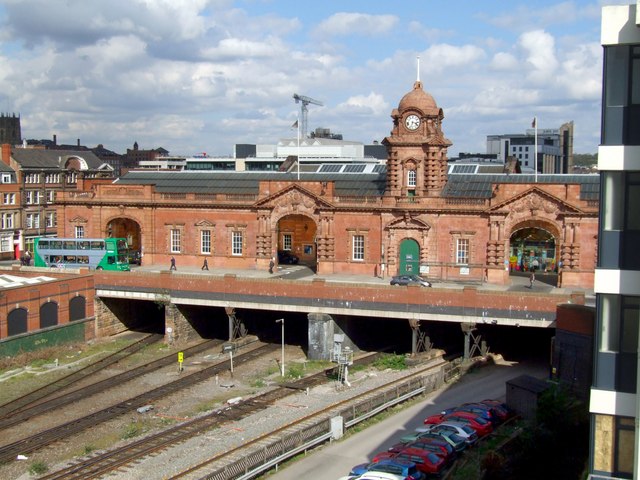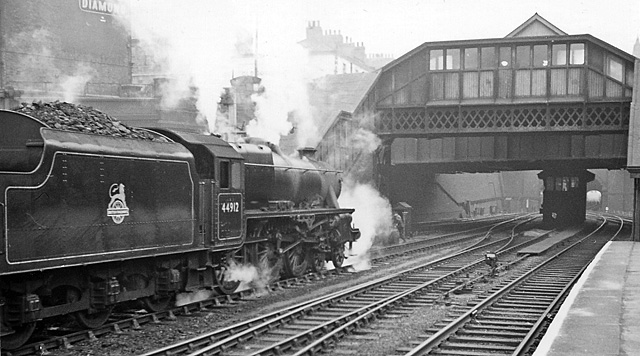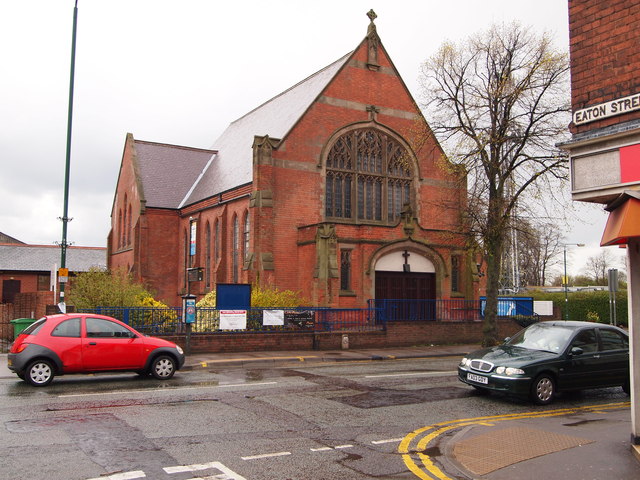|
Nottingham Station
Nottingham station, briefly known as Nottingham City and for rather longer as Nottingham Midland, is a railway station and tram stop in the city of Nottingham. It is the principal railway station of Nottingham. It is also a nodal point on the city's tram system, with a tram stop that was originally called Station Street but is now known as Nottingham Station. The station was first built by the Midland Railway (MR) in 1848 and rebuilt by the same company in 1904, with much of the current building dating from the later date. It is now owned by Network Rail and managed by East Midlands Railway (EMR). Besides EMR trains, it is also served by CrossCountry and Northern trains and by Nottingham Express Transit (NET) trams. The station was one of several that once served the city of Nottingham. Amongst these were the city centre stations of on the Great Central Railway, and on the Great Northern Railway; both of these stations are now closed. A number of minor stations served ... [...More Info...] [...Related Items...] OR: [Wikipedia] [Google] [Baidu] |
Nottingham
Nottingham ( , locally ) is a city and unitary authority area in Nottinghamshire, East Midlands, England. It is located north-west of London, south-east of Sheffield and north-east of Birmingham. Nottingham has links to the legend of Robin Hood and to the lace-making, bicycle and tobacco industries. The city is also the county town of Nottinghamshire and the settlement was granted its city charter in 1897, as part of Queen Victoria's Diamond Jubilee celebrations. Nottingham is a tourist destination; in 2018, the city received the second-highest number of overnight visitors in the Midlands and the highest number in the East Midlands. In 2020, Nottingham had an estimated population of 330,000. The wider conurbation, which includes many of the city's suburbs, has a population of 768,638. It is the largest urban area in the East Midlands and the second-largest in the Midlands. Its Functional Urban Area, the largest in the East Midlands, has a population of 919,484. The popula ... [...More Info...] [...Related Items...] OR: [Wikipedia] [Google] [Baidu] |
Midland Counties Railway
The Midland Counties' Railway (MCR) was a railway company in the United Kingdom which existed between 1839 and 1844, connecting Nottingham, Leicester and Derby with Rugby, Warwickshire, Rugby and thence, via the London and Birmingham Railway, to London. The MCR system connected with the North Midland Railway and the Birmingham and Derby Junction Railway in Derby at what become known as the Derby Midland railway station#History, Tri Junct Station. The three later merged to become the Midland Railway. Origin The East Midlands had for some years been at centre of Derby Midland railway station#Early East Midlands railway schemes, plans to link the major cities throughout the country. However, the MCR came about as a result of competition to supply coal to Leicester, a town which was rapidly industrialising and was a valuable market for coal. The competition was between the Coalville area of Leicestershire, and the Erewash Valley area of Nottinghamshire. For many years, the Notting ... [...More Info...] [...Related Items...] OR: [Wikipedia] [Google] [Baidu] |
Faience
Faience or faïence (; ) is the general English language term for fine tin-glazed pottery. The invention of a white pottery glaze suitable for painted decoration, by the addition of an oxide of tin to the slip of a lead glaze, was a major advance in the history of pottery. The invention seems to have been made in Iran or the Middle East before the ninth century. A kiln capable of producing temperatures exceeding was required to achieve this result, the result of millennia of refined pottery-making traditions. The term is now used for a wide variety of pottery from several parts of the world, including many types of European painted wares, often produced as cheaper versions of porcelain styles. English generally uses various other terms for well-known sub-types of faience. Italian tin-glazed earthenware, at least the early forms, is called maiolica in English, Dutch wares are called Delftware, and their English equivalents English delftware, leaving "faience" as the normal ... [...More Info...] [...Related Items...] OR: [Wikipedia] [Google] [Baidu] |
Baroque Revival
The Baroque Revival, also known as Neo-Baroque (or Second Empire architecture in France and Wilhelminism in Germany), was an architectural style of the late 19th century. The term is used to describe architecture and architectural sculptures which display important aspects of Baroque style, but are not of the original Baroque period. Elements of the Baroque architectural tradition were an essential part of the curriculum of the École des Beaux-Arts in Paris, the pre-eminent school of architecture in the second half of the 19th century, and are integral to the Beaux-Arts architecture it engendered both in France and abroad. An ebullient sense of European imperialism encouraged an official architecture to reflect it in Britain and France, and in Germany and Italy the Baroque Revival expressed pride in the new power of the unified state. Notable examples * Akasaka Palace (1899–1909), Tokyo, Japan * Alferaki Palace (1848), Taganrog, Russia * Ashton Memorial (1907–19 ... [...More Info...] [...Related Items...] OR: [Wikipedia] [Google] [Baidu] |
Edwardian
The Edwardian era or Edwardian period of British history spanned the reign of King Edward VII, 1901 to 1910 and is sometimes extended to the start of the First World War. The death of Queen Victoria in January 1901 marked the end of the Victorian era. Her son and successor, Edward VII, was already the leader of a fashionable elite that set a style influenced by the art and fashions of continental Europe. Samuel Hynes described the Edwardian era as a "leisurely time when women wore picture hats and did not vote, when the rich were not ashamed to live conspicuously, and the sun really never set on the British flag." The Liberals returned to power in 1906 and made significant reforms. Below the upper class, the era was marked by significant shifts in politics among sections of society that had largely been excluded from power, such as labourers, servants, and the industrial working class. Women started to play more of a role in politics. Roy Hattersley, ''The Edwardians'' (2004). ... [...More Info...] [...Related Items...] OR: [Wikipedia] [Google] [Baidu] |
Andrew Handyside And Company
Andrew Handyside and Company was an iron founder in Derby, England, in the nineteenth century. Biography Born in Edinburgh, Scotland, in 1805, Handyside worked in his uncle Charles Baird's engineering business in St. Petersburg before taking over the Brittania Foundry in 1848. It had first been opened around 1820 by Weatherhead and Glover to cast ornamental ironwork, and had achieved a high reputation, partly from the skill of the workers, but also because of the quality of the local moulding sand. By the 1840s it was diversifying into railway components. Among the early customers was the Midland Railway's Derby Works for which it supplied cylinder blocks and other castings. Although cast iron ornaments were going out of fashion, until the advent of steel there was an increasing demand for engineering and for iron framed construction. He concentrated in improving the strength of the material, which, when tested at Woolwich in 1854 proved to have a tensile strength of betw ... [...More Info...] [...Related Items...] OR: [Wikipedia] [Google] [Baidu] |
Sleaford
Sleaford is a market town and civil parish in the North Kesteven district of Lincolnshire, England. Centred on the former parish of New Sleaford, the modern boundaries and urban area include Quarrington to the south-west, Holdingham to the north and Old Sleaford to the east. The town is on the edge of the fertile Fenlands, north-east of Grantham, west of Boston, and south of Lincoln. Its population of 17,671 at the 2011 Census made it the largest settlement in the North Kesteven district; it is the district's administrative centre. Bypassed by the A17 and the A15, it is linked to Lincoln, Newark, Peterborough, Grantham and King's Lynn. The first settlement formed in the Iron Age where a prehistoric track crossed the River Slea. It was a tribal centre and home to a mint for the Corieltauvi in the 1st centuries BC and AD. Evidence of Roman and Anglo-Saxon settlement has been found. The medieval records differentiate between Old and New Sleaford, the latter emerging by the 1 ... [...More Info...] [...Related Items...] OR: [Wikipedia] [Google] [Baidu] |
Kirk And Parry
Kirk and Parry were an architectural and civil engineering practice in Sleaford that specialised in the design of public buildings, housing and the construction of Railways. The practice was initially founded by Charles Kirk (senior) (1791–1847). Thomas Parry, (1818-1879) was an articled clerk to Charles Kirk. Parry married Henrietta, daughter of Charles Kirk in 1841 and formed a partnership with Charles Kirk. Following the death of Charles Kirk in 1847, his son, Charles Kirk (junior) (1825-1902), then became a partner with Thomas Parry. Charles Kirk Junior was the architect in the practice and Parry probably acted as an administrator. Thomas Parry was a Liberal Party politician from who sat in the House of Commons for three short periods between 1865 and 1874. By 1903 the firm had changed its name to Kirk, Knight and Co. This article surveys the work of Kirk and Parry and its successor firm, from 1847 until it ceased trading in 1906. Public Buildings *Sleaford Corn ... [...More Info...] [...Related Items...] OR: [Wikipedia] [Google] [Baidu] |
Derby
Derby ( ) is a city and unitary authority area in Derbyshire, England. It lies on the banks of the River Derwent in the south of Derbyshire, which is in the East Midlands Region. It was traditionally the county town of Derbyshire. Derby gained city status in 1977, the population size has increased by 5.1%, from around 248,800 in 2011 to 261,400 in 2021. Derby was settled by Romans, who established the town of Derventio, later captured by the Anglo-Saxons, and later still by the Vikings, who made their town of one of the Five Boroughs of the Danelaw. Initially a market town, Derby grew rapidly in the industrial era. Home to Lombe's Mill, an early British factory, Derby has a claim to be one of the birthplaces of the Industrial Revolution. It contains the southern part of the Derwent Valley Mills World Heritage Site. With the arrival of the railways in the 19th century, Derby became a centre of the British rail industry. Derby is a centre for advanced transport manu ... [...More Info...] [...Related Items...] OR: [Wikipedia] [Google] [Baidu] |
Carrington Street, Nottingham
Carrington Street is a street in Nottingham city centre between Nottingham station and Broadmarsh. History The street was laid out by Henry Moses Wood, Surveyor in 1828. The opportunity offered by the construction of this new road was taken to install a large culvert in circumference as a storm drain, to carry water to the River Leen. The River Leen was dredged by approximately to provide additional capacity. In 1842 a bridge was constructed over the Nottingham and Beeston Canal to provide access to Nottingham Carrington Street railway station. The bridge costing £6,000 () was partly sponsored by the Midland Counties' Railway. It contained an inscription which read: This bridge was commenced in August, 1841, J.M.B. Pigot M.D., Mayor, and completed in October, 1842, R. Morley Esq., Mayor, H.M. Wood, Architect. The bridge was widened in 1904 when the new Nottingham station was erected. Having crossed the canal, the street arrived at Nottingham Carrington Street railway st ... [...More Info...] [...Related Items...] OR: [Wikipedia] [Google] [Baidu] |
Nottingham Victoria Railway Station
Nottingham Victoria railway station was a Great Central Railway and Great Northern Railway railway station in Nottingham, England. It was designed by the architect Albert Edward Lambert, who also designed the rebuild of the Nottingham Midland station (now known simply as Nottingham station). It was opened by the Nottingham Joint Station Committee on 24 May 1900 and closed on 4 September 1967 by the London Midland Region of British Railways. The station building was entirely demolished (except the clock tower), and the Victoria Centre shopping centre was built on the site, incorporating the old station clock tower into the main entrance on Milton Street (the continuation of Mansfield Road). Background In 1893 the Manchester, Sheffield and Lincolnshire Railway obtained authorisation to extend its North Midlands railway network into London. This new line was opened on 15 March 1899 (by which time the railway company was known as the Great Central Railway) and became known as t ... [...More Info...] [...Related Items...] OR: [Wikipedia] [Google] [Baidu] |
Albert Edward Lambert
Albert Edward Lambert FRIBA (27 May 1869 – 5 November 1929) was an architect based in Nottingham, England. Family He was born in Manton in Rutland on 27 May 1869. He was the son of John Lambert and Louisa. By 1871 the family had moved to Draycott in Derbyshire and in 1881 the family were living at the Grocers Shop & Cottage, Wetheral, Cumberland, England. In the 1891 census, he was living at 7 Wilfred Street in Derby, with his mother Louisa, and brother George. Albert's profession is given as Architect's assistant. In 1895 he was living a6 Norfolk Street, Derby He married Annie Elizabeth Robinson, daughter of Michael H Robinson (butcher and farmer) and Ann, at the end of 1897. In 1901 he was living at 8 Douglas Road, Nottingham and he subsequently lived on Richmond Drive and then Woodland Drive in Mapperley Park in Nottingham. His daughter Jessie Kathleen was born on 18 April 1901. In 1911, he was living at Hillcrest, Warwick Road, Nottingham, (1911 UK Census) and then m ... [...More Info...] [...Related Items...] OR: [Wikipedia] [Google] [Baidu] |



.jpg)






